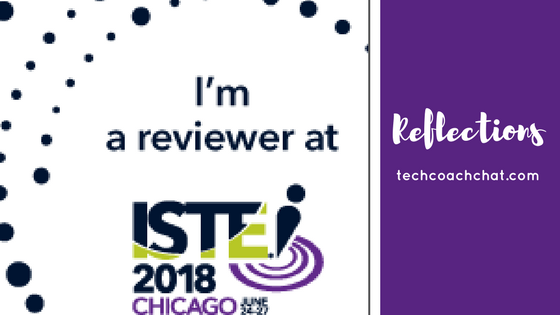Being an active part of and ISTE PLN has helped my professional learning in a number of ways. I am a proposal reviewer for our PLN again this year. I love the opportunity it’s a great way to learn about what is going on in edtech outside of my neck of the woods. Since I am about to finish up my reviews, I figure it’s a great time to reflect on what I’ve seen and what I think makes a great proposal. Hopefully I’ll remember this post next year when I start writing my proposals and use some of these tips. 🙂
One of the most important things is to pick the right session format and topic. I know, it sounds ridiculous – who would pick the wrong format? You’d be surprised. This year, some of the proposals that I read said they were interactive and then had no stated audience participation or activities or anything other than lecture indicated in the summary. I know we all want to be included in the learning experience, but there is a time and place for lecture. Don’t be afraid to be upfront and say this is a lecture. If you end up in the wrong category, then your proposal has to be referred to a different group, and that makes things difficult for everyone.
I really appreciated the proposals that spelled out how they planned to address the ISTE standards. Matching your content to the standards is a bit difficult as you are writing – I know from experience. It was obvious that some of the folks planned their proposal and went back afterwards to do this part. Explaining the alignments shows two things: you know the ISTE standards and you have a plan on how to help participants meet them.
There are two ways that people seemed to lay out their purpose and objectives. Teachers and teacher types typically used a PWBAT (Participant Will Be Able To) format with a bulleted list of objectives. You can always tell who looks at PD like instruction…Others wrote in more general terms a paragraph or two – more like a rationale.
As a reviewer, the more detailed outlines helped me to envision the timing and the flow of activities. There were some that I just couldn’t understand…others told me exactly what the presenter was hoping to accomplish. It was interesting that some managed to say what they were going to do and yet convey no real information…
The logistician in me loves to see supporting research. Listing books, articles and/or blog posts tell me that the person has done some research – enough to know that this idea has support from the literature…in my mind, innovation is great so long as it’s based on something that we already know works.
There are a number of other items that go into scoring a proposal…Higher-order application of a theory or technology is important as are timeliness, replicability, and evidence of success or student improvement. Additionally, participants should be able to gain new knowledge.
This video probably gives a better look at the whole process..https://youtu.be/0LGl-uOmpkc


